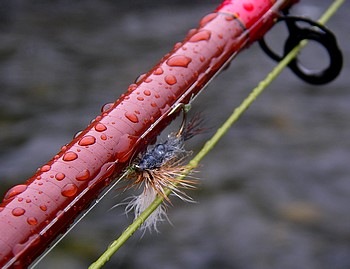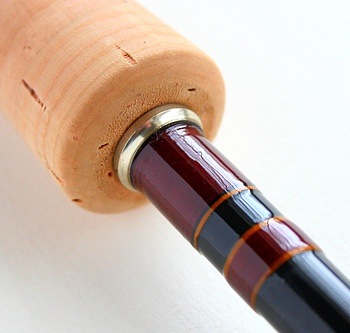They're obsolete. They're low tech. They're soooo 1960s. So why are fiberglass fly rods reappearing on rivers and streams?[ed: This is Part I of the series; read
Part II here,
Part III here]
It's hard to define the "rightness" of a fly rod, though once -- over a couple beers -- a few local fly fishermen delved into the subject at what amounted to the genetic level.
Naturally, we didn't stumble on any real answers (none that we remember anyway), outside of the fact that technology is not necessarily the one true path to fly rod enlightenment.
That's why -- when fly fishers ask me if one rod is "better" than another -- I suggest they simply fish whatever fly rod feels best, and the hell with what the magazines want you to think
In this
rare instance, I've taken my own advice; I fish fiberglass and bamboo fly rods almost exclusively, and not because I want to fire up fly fishing's natural/synthetic class wars.
The simple truth is this: fiberglass and bamboo fly rods feel "” to me anyway "”
exactly how a fly rod is
supposed to feel.
 The unsanded, retro-look Steffen rods don't appeal to everyone, but I like 'em.
The unsanded, retro-look Steffen rods don't appeal to everyone, but I like 'em.They bend smoothly, and do so without the stiffness that sometimes leads me to
drive my graphite fly rods.
During the casting stroke, I've got a pretty good idea exactly what's going on at the far end of my fiberglass fly rods, and glass inspires serious confidence when I've got a good fish going on a small fly or light tippet.
In simplest terms, they're unpretentious, durable, affordable, un-demanding, -- and just plain fun. All of those fit pretty neatly within the job description of your average fly rod, and as somebody once observed, "love is simply a compendium of needs."
Read More The Underground Picks the Dozen Best Fly Rods of All Time Period
The Modern Fiberglass Fly RodShortly after WWII, fiberglass fly rods took over the industry; glass was the new glamour material, though after the market settled in a bit, hand-crafted bamboo rods still occupied the more rarefied upper strata of the fly rod world, with fiberglass largely ruling the rest of the market.
Compared to bamboo, fiberglass fly rods offered lighter weight, less cost, and all the maintenance demands of your average doorstop.
Sadly, the fiberglass fly rod's heyday was short-lived; while it was on the fast track to the top of the heap by the late 1940s, by the mid-70s it was already headed for the sale bins, courtesy the flashier, lighter graphite fly rods.
In truth, rodmakers were only starting to unravel the mysteries of fiberglass when it fell from favor, and today, fiberglass fly rods occupy a tiny "” but growing "” corner of fly rod market.
A few larger fly rod manufacturers have stepped up with new (or re-issued) models, but sitting squarely at the center of the industry you'll find a handful of tiny fly rod companies "” people turning out what are probably the best-casting, most-advanced fiberglass fly rods of all time.
Today's fiberglass fly rods are light. They're strong. They're affordable (compared to high-end bamboo and graphite). And they offer a hard-to-define casting feel that higher modulus materials (like graphite) simply can't match.
They're also exceptional fishing tools for trout, good enough that a few of us have openly wondered if the best light trout rods in existence aren't currently being built from s-glass fiberglass.
The Bamboo ConnectionWhile you'll find modern fiberglass fly rods in the hands of cranks and misfits everywhere, they're also finding a toehold among bamboo rod fanatics -- bamboo fiends who can't keep up with spiraling bamboo rod costs, or want more-replaceable travel rods that still retain bamboo's smooth "feel."
After all, estimates for bamboo's modulus average around 10 million "” the same modulus offered by e-glass fiberglass.
S-glass fiberglass ranks slightly higher at 12 million modulus, but all three offer ratings far below carbon fiber (graphite) fly rod materials, which typically start above 30 million modulus and go higher from there.
 A custom-built 8' 5wt Diamondglass fly rod; even bamboo hounds like the way it casts.
A custom-built 8' 5wt Diamondglass fly rod; even bamboo hounds like the way it casts.Modulus is hardly the whole story, but it's not a stretch to say that fiberglass rods cast and fish more like bamboo than they do graphite.
In fact, its sweet casting "feel" is probably driving renewed interest in fiberglass; the rods can cast and fish like fine bamboo rods, but do so at a fraction of the price, a fraction of the weight, and without any special maintenance demands.
Contemporary vs Vintage Fiberglass RodsI'm not going to spend much time on vintage fiberglass; unraveling the brands would take many, many pages. I will say there is a lot of vintage glass out there, and many of the rods are exceptional (Phillipsons, Scotts, Winstons, Fishers, Hardys, etc).
Sadly, many are also un-exceptional, and many of the fiberglass fly rods from the Golden Era also exhibit what you'd charitably say were the gaudiest finishes ever conceived by a fly rod manufacturer.
Mylar underwraps and spiral wraps might seem refreshingly nostalgic to some, but not me.
If you're truly interested in vintage glass rods, buy a copy of the Fiberglass Fly Rod by the Johnsons (a father and son team). For vintage glass freaks, it's the bible.
The focus of this article are the exemplary glass rods produced by today's makers "” rods that enjoy the benefit of fiberglass technologies unknown (or not practiced) during the "Golden Age" of fiberglass.
What's New In An Old TechnologyDuring the industry transition from bamboo to fiberglass, glass rods were designed to replicate the slower action of bamboo rods. It took designers more than a few years to truly get the feel of the material, which is when the race for faster-action rods (a race carried over into today's graphite rods) took place.
Fortunately, today's fiberglass rod builders don't have to build rods that replicate bamboo's feel, or satisfy the cravings of a mass market bent on ever-steeper "parking lot" tapers.
Instead, they're free to build right to the sweet spot of the material. As a result, the majority of modern glass rods are smooth and progressive, and though some makers (like McFarland) are experimenting with steep "dry fly" tapers and even parabolic tapers, most modern glass rods fall nicely into the middle of the action spectrum.
Frankly, that makes sense; as a rod-building material, fiberglass doesn't typically fabricate into a stellar fast-action rod as well as high modulus graphite, but it does a wonderful job in smooth-flexing progressive and slower tapers.
The Weight QuestionWhile today's fiberglass fly rods aren't as light as the latest high-modulus graphite rods, I'd suggest they're plenty light enough, especially in the sub-9' lengths (which is almost all of them).
Excising a quarter of an ounce from a fly rod never seems as significant to me as it does to rodmakers trying sell expensive new fly rods, and if that's your criteria for rod selection, then fiberglass probably isn't for you.
These aren't thundersticks after all, and the users of modern fiberglass aren't typically bent on world casting domination.
Rather -- if you believe casting "feel" is an integral part of the fly fishing experience -- then fiberglass is worth consideration, especially on smaller streams and rivers.
That's where short-range accuracy and "fun" (fly fishing's oft-forgotten legacy) are key.
In Part II of the Underground's fiberglass fly rod series, we look at who's building fiberglass rods and why you may -- or may not -- want one.[ed: This is Part I of the series; read
Part II here,
Part III here]